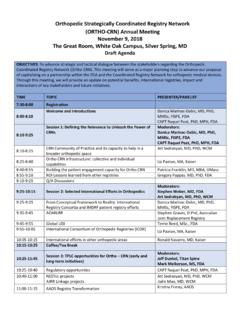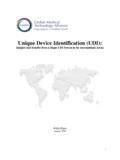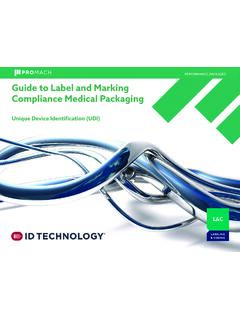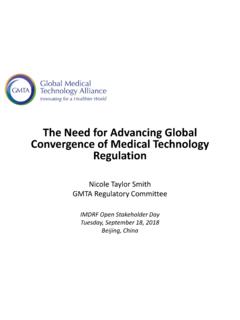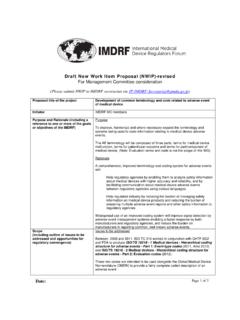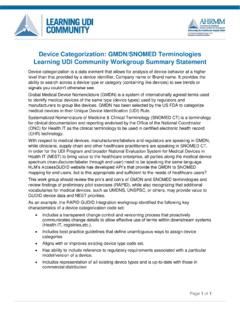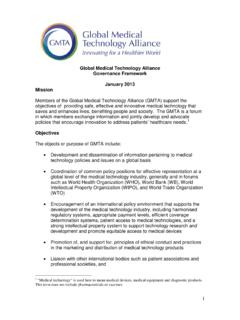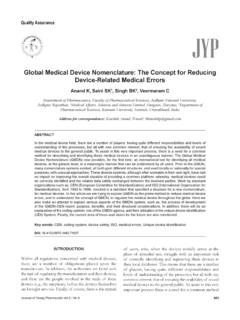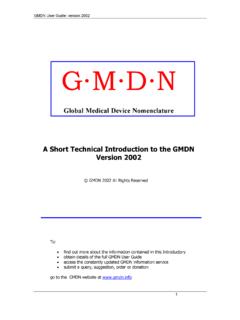Transcription of Assessment of Peripheral Devices (RAPID) - MDEpiNet.org
1 Registry Assessment of Peripheral Interventional Devices (RAPID) Phase I Deliverables July 14, 2016 This document defines the RAPID project and artifacts that together constitute the package of deliverables for Phase I. 1 Table of Contents Executive Summary .. 3 RAPID Leadership .. 4 RAPID Stakeholder and Working Group Member Organizations .. 5 Background .. 6 Approach .. 7 Deliverables .. 8 Core Data Element Spreadsheet .. 8 Use Cases .. 9 Workflow Diagrams .. 9 Global Unique Device Identification (GUDID) Working Group Project Summary .. 9 2 Executive Summary The Registry Assessment of Peripheral Interventional Devices (RAPID) project emerged from the Predictable And SuStainable Implementation Of National (PASSION) Registries for Cardiovascular Devices program of the medical Device Epidemiology Network (MDEpiNet), a public private partnership supported by the FDA to advance the nation's approaches to the evaluation of medical Devices .
2 It is one project in a series initiated to advance and demonstrate the interoperable flow of data and information across electronic health information systems as a precursor to the National Evaluation System for Health Technology (NEST) articulated by Drs. Shuren and Califf1. The MDEpiNet RAPID project is designed to advance the foundational elements of a total product lifecycle (TPLC) approach for the evaluation of medical Devices used to treat and manage Peripheral artery disease. RAPID is focused on Devices for Peripheral arterial intervention as an archetype of the envisioned TPLC ecosystem. Standard data elements related to the care and treatment of patients with Peripheral artery disease are being developed for use with data elements from the Global Unique Device Identification Database (GUDID) database to create a structured dataset that supports pre and post market Assessment , quality improvement, and safety surveillance of Peripheral interventional Devices (Phase I).
3 Subsequent phases will validate the potential of the data elements for implementation in various healthcare information systems such that structured, interoperable data is collected at the point of care and is available for use by patient registries, clinical research and medical device evaluation initiatives. Additionally, the RAPID data elements will inform the development of a global case report form and data collection instruments needed in the interim. As such, this work facilitates Peripheral interventional device development, addresses regulatory needs, and creates efficiencies that will reduce overall time and costs and support quality improvement efforts across the medical device lifecycle.
4 1. Shuren J and Califf RM, Need for a national evaluation system for health technology. JAMA published online July 11, 2016. 3 RAPID Leadership Co Chairs: Pablo Morales, Food and Drug Administration (FDA) Robert Thatcher, 4C medical Technologies Jack Cronenwett, Society for Vascular Surgery (SVS) Vascular Quality Initiative (VQI) MDEpiNet Key Advisors: Mitchell Krucoff, Duke Clinical Research Institute (DCRI) Danica Marinac Dabic, Food and Drug Administration (FDA) Working Group Chairs: W. Schuyler Jones, Duke Clinical Research Institute (DCRI) Terrie Reed, Food and Drug Administration (FDA) James Tcheng, Duke Clinical Research Institute (DCRI) Project Management and Informatics Support: Rebecca Wilgus, Duke Clinical Research Institute (DCRI) Anne Heath, Duke Clinical Research Institute (DCRI) Mary Williams, Duke Clinical Research Institute (DCRI) 4 RAPID Stakeholder and Working Group Member Organizations 3 Major US Professional societies / registries American College of Cardiology (ACC): National Cardiovascular Disease Registry (NCDR) Society of Interventional Radiology (SIR).
5 National Interventional Radiology Quality Registry (NIRQR) Society for Vascular Surgery (SVS): Vascular Quality Initiative (VQI) 5 International Partners Japan's Pharmaceuticals and medical Devices Agency (PMDA) Global medical Device Nomenclature Agency (GMDNA) Australian Vascular Audit German Vascular Society Northern German Association for Vascular Medicine 7 Government Agencies FDA (CDRH pre and post market, and CDER) Agency for Healthcare Research and Quality (AHRQ) Centers for Medicare and Medicaid Services (CMS) Department of Defense (DOD) Healthcare Resources Office of the National Coordinator (ONC) National Heart, Lung and Blood Institute (NHLBI) National Library of Medicine (NLM)
6 6 EHR / Registry/Clinical Research Companies Epic M2S MedStreaming Health Jump Boston Biomedical Associates Novella Clinical, Quintiles 12 Vascular Device Manufacturers Abbott Aortic medical Inc. Avinger Boston Scientific Cardiovascular Systems Inc. Cook medical CR Bard Medtronic Spectranetics Corp Terumo Volcano Corp/Phillips Health Technology WL Gore 5 Background The importance of creating an interoperable infrastructure to support medical device evaluation and surveillance across the total product lifecycle is widely recognized and many efforts are currently in progress2,3 Structured clinical data elements are an essential component of an interoperable infrastructure in which clinically based data sources (procedure documentation systems, electronic health record systems, patient registries)
7 Can be linked or leveraged with claims data, patient reported outcomes data, and data from other sources needed to aggregate and analyze multi sourced data sets required to generate evidence across the total product life cycle for medical Devices . Collectively, this evidence is necessary to reduce time to market for new Devices , extend indications for use, inform device design and modification, define best practices for selection and use of medical Devices , and support aggregate analysis of clinical and economic outcomes (including risks and benefits) across device types for real world patient populations. It facilitates rapid identification of problematic Devices as well as accurate and timely dissemination of information about device performance to clinicians, patients, and manufacturers1.
8 Although great strides have been made in some areas, in Peripheral artery disease (PAD) much work remains. A recent systematic review of treatment strategies for patients with PAD concluded that insufficient evidence exists to support many treatment options over others4. Factors contributing to the heterogeneity of treatment include but are not limited to: The large array of treatments and Devices used (both on and off label) to treat and manage PAD The variety of medical specialties performing PAD procedures, including vascular surgeons, interventional cardiologists and interventional radiologists, each of whom bring specific competencies and approaches to managing patients with PAD 2.
9 Krucoff MW, Sedrakyan A, Normand SL. Bridging Unmet medical Device Ecosystem Needs With Strategically Coordinated Registries Networks. JAMA 2015: 314:1691 1962. 3. Krucoff, MW, Normand SL, Edwards F, Lystig, T. Recommendations for a National medical Device Evaluation System: Strategically Coordinated Registry Networks to Bridge Clinical Care and Research. A Report from the medical Device Registry Taskforce & the medical Devices Epidemiology Network. Accessed July 18, 2016. 4. Jones WS, Schmit KM, Vemulapalli S, Subherwal S, Patel MR, Hasselblad V, Heidenfelder BL, Chobot MM, Posey R, Wing L, Sanders GD, Dolor RJ. Treatment Strategies for Patients With Peripheral Artery Disease.
10 Comparative Effectiveness Review No. 118. (Prepared by the Duke Evidence based Practice Center under Contract No. 290 . 2007 10066 I.) AHRQ Publication No. 13 EHC090 EF. Rockville, MD: Agency for Healthcare Research and Quality; May 2013. 6 The relatively few large comparative effectiveness studies that stratify patients by risk and/or disease severity or treatment/device type The existence of multiple registries focused on PAD defined according to physician specialty rather than reflecting the entirety of the patient population and care practices Lack of structured data that links specific Devices (unique device identifiers) with the patients in which they are used/implanted In order to improve many aspects of PAD device evaluation, the RAPID project was initiated.
